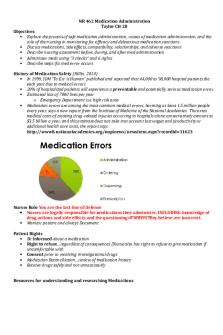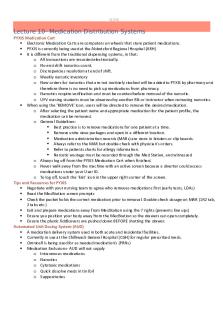8 rights of medication administration PDF

| Title | 8 rights of medication administration |
|---|---|
| Author | Sarai Chavarria |
| Course | Reproductive Health |
| Institution | Prince George's Community College |
| Pages | 1 |
| File Size | 46.4 KB |
| File Type | |
| Total Downloads | 83 |
| Total Views | 167 |
Summary
list of medication administration rights to practice for exams...
Description
R f
N rsi
2012 D
H
db
k (2012) Li
i
tt Willi
& Wilki
8 rights of medication administration May 27, 2011 00:10 by
Lisa Bonsall, MSN, RN, CRNP
Chances are that some of you may not have known that in addition to the well-known 5 right of medication administration, some experts have added 3 more to the list.When it comes to patient safety, it’s never a bad time to review some of the basics and increase your awareness of newer recommendations. Please add any of your own tips and medication safety advice by leaving a comment. Thanks! Rights of Medication Administration 1. Right patient Check the name on the order and the patient. Use 2 identifiers. Ask patient to identify himself/herself. When available, use technology (for example, bar-code system). 2. Right medication Check the medication label. Check the order. 3. Right dose Check the order. Confirm appropriateness of the dose using a current drug reference. If necessary, calculate the dose and have another nurse calculate the dose as well. 4. Right route Again, check the order and appropriateness of the route ordered. Confirm that the patient can take or receive the medication by the ordered route. 5. Right time Check the frequency of the ordered medication. Double-check that you are giving the ordered dose at the correct time. Confirm when the last dose was given. 6. Right documentation Document administration AFTER giving the ordered medication. Chart the time, route, and any other specific information as necessary. For example, the site of an injection or any laboratory value or vital sign that needed to be checked before giving the drug. 7. Right reason Confirm the rationale for the ordered medication. What is the patient’s history? Why is he/she taking this medication? Revisit the reasons for long-term medication use. 8. Right response Make sure that the drug led to the desired effect. If an antihypertensive was given, has his/her blood pressure improved? Does the patient verbalize improvement in depression while on an antidepressant? Be sure to document your monitoring of the patient and any other nursing interventions that are applicable....
Similar Free PDFs

Medication Administration
- 3 Pages

Medication Administration
- 6 Pages

Chapter 31 Medication Administration
- 18 Pages

Chapter 31 Medication Administration
- 27 Pages

Test 1 Medication Administration
- 9 Pages

Chapter 35 Medication Administration
- 16 Pages
Popular Institutions
- Tinajero National High School - Annex
- Politeknik Caltex Riau
- Yokohama City University
- SGT University
- University of Al-Qadisiyah
- Divine Word College of Vigan
- Techniek College Rotterdam
- Universidade de Santiago
- Universiti Teknologi MARA Cawangan Johor Kampus Pasir Gudang
- Poltekkes Kemenkes Yogyakarta
- Baguio City National High School
- Colegio san marcos
- preparatoria uno
- Centro de Bachillerato Tecnológico Industrial y de Servicios No. 107
- Dalian Maritime University
- Quang Trung Secondary School
- Colegio Tecnológico en Informática
- Corporación Regional de Educación Superior
- Grupo CEDVA
- Dar Al Uloom University
- Centro de Estudios Preuniversitarios de la Universidad Nacional de Ingeniería
- 上智大学
- Aakash International School, Nuna Majara
- San Felipe Neri Catholic School
- Kang Chiao International School - New Taipei City
- Misamis Occidental National High School
- Institución Educativa Escuela Normal Juan Ladrilleros
- Kolehiyo ng Pantukan
- Batanes State College
- Instituto Continental
- Sekolah Menengah Kejuruan Kesehatan Kaltara (Tarakan)
- Colegio de La Inmaculada Concepcion - Cebu









